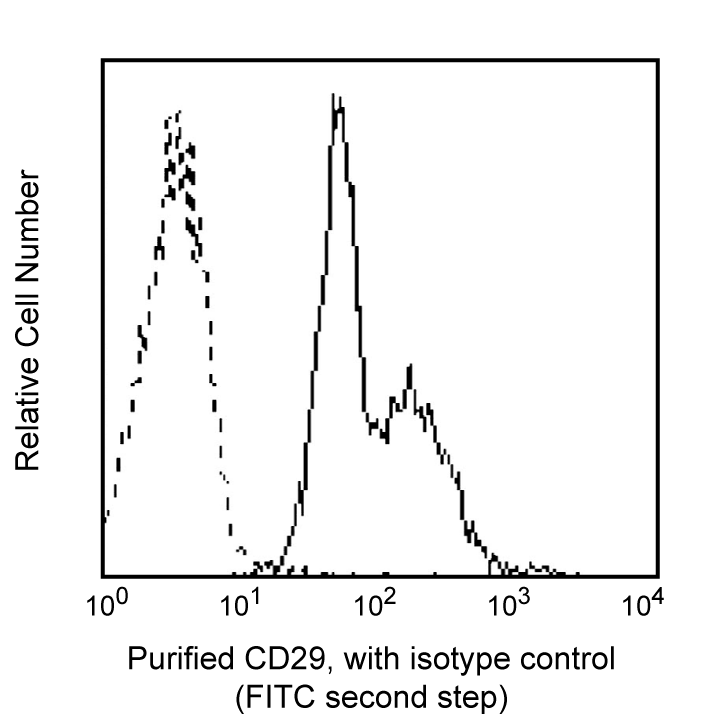Old Browser
Looks like you're visiting us from {countryName}.
Would you like to stay on the current country site or be switched to your country?




Flow cytometric analysis of CD29 expression on human peripheral blood lymphocytes. Whole blood was stained with Purified Rat Anti-Human CD29 antibody (Cat. No. 552828; solid line histogram) or with Purified Rat IgG2a, κ Isotype Control (Cat. No. 553927/555841; dashed line histogram), followed by FITC Goat Anti-Rat Ig (Cat. No 554016). Erythrocytes were lysed with BD Pharm Lyse™ Lysing Buffer (Cat. No. 555899). The fluorescence histograms were derived from gated events with the forward and side light-scatter characteristics of viable lymphocytes.


BD Pharmingen™ Purified Rat Anti-Human CD29

Regulatory Status Legend
Any use of products other than the permitted use without the express written authorization of Becton, Dickinson and Company is strictly prohibited.
Preparation And Storage
Product Notices
- Since applications vary, each investigator should titrate the reagent to obtain optimal results.
- Please refer to www.bdbiosciences.com/us/s/resources for technical protocols.
- Caution: Sodium azide yields highly toxic hydrazoic acid under acidic conditions. Dilute azide compounds in running water before discarding to avoid accumulation of potentially explosive deposits in plumbing.
- For fluorochrome spectra and suitable instrument settings, please refer to our Multicolor Flow Cytometry web page at www.bdbiosciences.com/colors.
- An isotype control should be used at the same concentration as the antibody of interest.
The Mab 13 monoclonal antibody specifically binds to CD29. CD29 is a 130 kDa integrin β1 subunit that is expressed as a heterodimeric complex with one of six distinct α subunits, comprising the very late activation antigen (VLA) subfamily of adhesion receptors. The family of β1 integrins includes receptors for vascular cell adhesion molecule 1 (VCAM-1), extracellular matrix (ECM) components such as collagen (COL), fibronectin (FN), laminin (LM) and vitronectin (VN), and pathogens. The β1 subunit is widely expressed by T and B cells, dendritic cells, NK cells, monocytes and macrophages, granulocytes, platelets, endothelial and epithelial cells, and stem cells.
Development References (14)
-
Akiyama SK, Larjava H, Yamada KM. Differences in the biosynthesis and localization of the fibronectin receptor in normal and transformed cultured human cells. Cancer Res. 1990 March; 50(50):1601-1607. (Biology). View Reference
-
Akiyama SK, Yamada SS, Chen WT, Yamada KM. Analysis of fibronectin receptor function with monoclonal antibodies: roles in cell adhesion, migration, matrix assembly, and cytoskeletal organization. J Cell Biol. 1989 August; 109(2):863-875. (Immunogen). View Reference
-
Bohnsack JF. CD11/CD18-independent neutrophil adherence to laminin is mediated by the integrin VLA-6. Blood. 1992 March; 79(6):1545-1552. (Biology). View Reference
-
Chan BM, Elices MJ, Murphy E, Hemler ME. Adhesion to vascular cell adhesion molecule 1 and fibronectin. Comparison of alpha 4 beta 1 (VLA-4) and alpha 4 beta 7 on the human B cell line JY. J Biol Chem. 1992 April; 267(12):8366-8370. (Biology). View Reference
-
Ennis E, Isberg RR, Shimizu Y. Very late antigen 4-dependent adhesion and costimulation of resting human T cells by the bacterial beta 1 integrin ligand invasin. J Exp Med. 1993 January; 177(1):207-212. (Biology). View Reference
-
Guo M, Kim LT, Akiyama SK, Gralnick HR, Yamada KM, Grinnell F. Altered processing of integrin receptors during keratinocyte activation. Exp Cell Res. 1991 August; 195(2):315-322. (Biology). View Reference
-
Hemler ME, Bodorova J, Kawaguchi S, Weitzman J, Kassner P. Adhesion structures subpanel 6, β1 integrins/VLA: CD29/CD49. In: Schlossman SF. Stuart F. Schlossman .. et al., ed. Leucocyte typing V : white cell differentiation antigens : proceedings of the fifth international workshop and conference held in Boston, USA, 3-7 November, 1993. Oxford: Oxford University Press; 1995:1609-1612.
-
Hertle MD, Adams JC, Watt FM. Integrin expression during human epidermal development in vivo and in vitro. Development. 1991 May; 112(1):193-206. (Biology). View Reference
-
Hynes RO. Integrins: versatility, modulation, and signaling in cell adhesion. Cell. 1992; 69(1):11-25. (Biology). View Reference
-
Larjava H, Peltonen J, Akiyama SK, et al. Novel function for beta 1 integrins in keratinocyte cell-cell interactions. J Cell Biol. 1990 March; 110(3):803-815. (Biology). View Reference
-
Massia SP, Hubbell JA. Vascular endothelial cell adhesion and spreading promoted by the peptide REDV of the IIICS region of plasma fibronectin is mediated by integrin alpha 4 beta 1. J Biol Chem. 1992 July; 267(20):14019-14026. (Biology). View Reference
-
Peltonen J, Larjava H, Jaakkola S, et al. Localization of integrin receptors for fibronectin, collagen, and laminin in human skin. Variable expression in basal and squamous cell carcinomas. J Clin Invest. 1989 December; 84(6):1916-1923. (Biology). View Reference
-
Rodriguez RM, Pitzalis C, Kingsley GH, Henderson E, Humphries MJ, Panayi GS. T lymphocyte adhesion to fibronectin (FN): a possible mechanism for T cell accumulation in the rheumatoid joint. Clin Exp Immunol. 1992 September; 89(3):439-445. (Biology). View Reference
-
Teixidó J, Hemler ME, Greenberger JS, Anklesaria P. Role of beta 1 and beta 2 integrins in the adhesion of human CD34hi stem cells to bone marrow stroma. J Clin Invest. 1992 August; 90(2):358-367. (Biology). View Reference
Please refer to Support Documents for Quality Certificates
Global - Refer to manufacturer's instructions for use and related User Manuals and Technical data sheets before using this products as described
Comparisons, where applicable, are made against older BD Technology, manual methods or are general performance claims. Comparisons are not made against non-BD technologies, unless otherwise noted.
For Research Use Only. Not for use in diagnostic or therapeutic procedures.
Refer to manufacturer's instructions for use and related User Manuals and Technical Data Sheets before using this product as described.
Comparisons, where applicable, are made against older BD technology, manual methods or are general performance claims. Comparisons are not made against non-BD technologies, unless otherwise noted.
Report a Site Issue
This form is intended to help us improve our website experience. For other support, please visit our Contact Us page.
.png?imwidth=320)